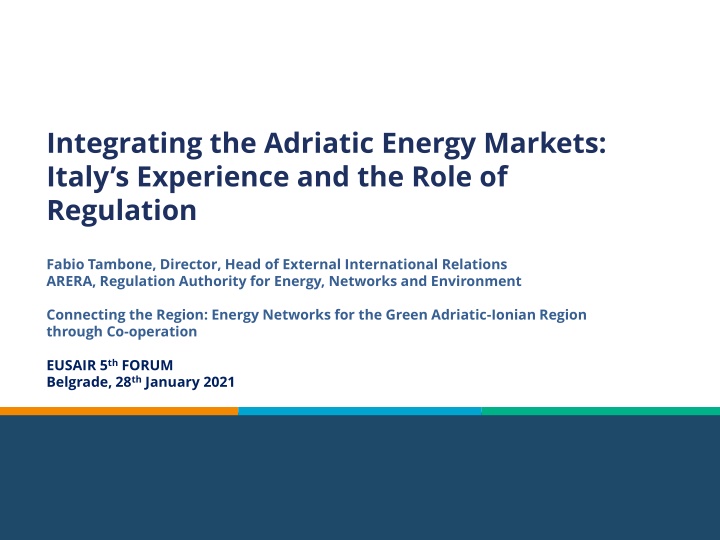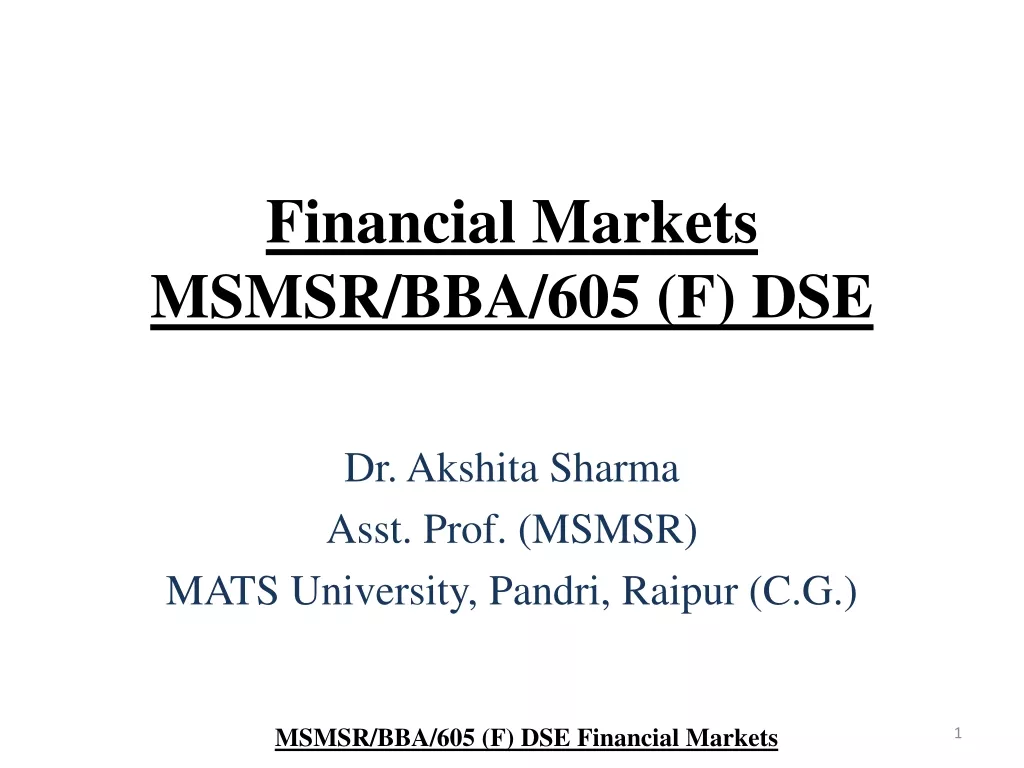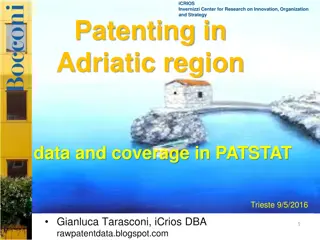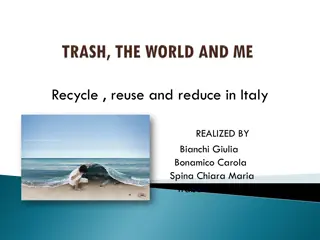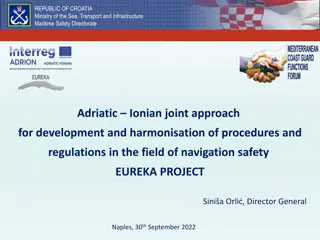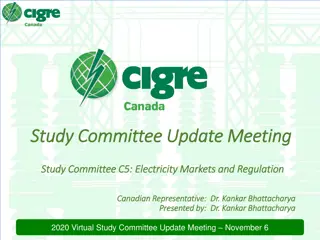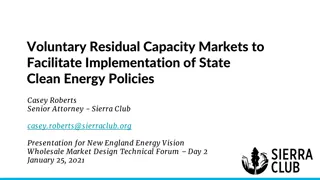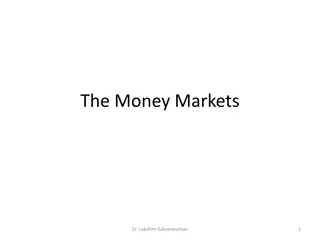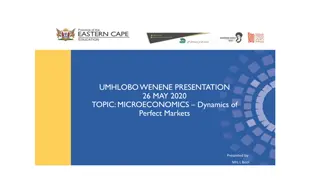Integrating Adriatic Energy Markets: Italy's Regulatory Perspective
The presentation delves into Italy's experience in integrating Adriatic energy markets and the crucial role of regulation by ARERA. Exploring the promotion of markets integration, the talk highlights regulatory convergence in practice through projects like the MONITA interconnection. Italy's Regulatory Authority for Energy, Networks, and Environment (ARERA) stands as an independent body spearheading regulation across various sectors, ensuring stakeholder involvement, financial stability, and cooperation at both national and EU levels. The structural changes in energy infrastructure emphasize Italy's pivotal position in facilitating increased interconnection capacity, transforming from a heavy importer to a substantial contributor to the EU's energy security.
Download Presentation

Please find below an Image/Link to download the presentation.
The content on the website is provided AS IS for your information and personal use only. It may not be sold, licensed, or shared on other websites without obtaining consent from the author.If you encounter any issues during the download, it is possible that the publisher has removed the file from their server.
You are allowed to download the files provided on this website for personal or commercial use, subject to the condition that they are used lawfully. All files are the property of their respective owners.
The content on the website is provided AS IS for your information and personal use only. It may not be sold, licensed, or shared on other websites without obtaining consent from the author.
E N D
Presentation Transcript
Integrating the Adriatic Energy Markets: Italy s Experience and the Role of Regulation Fabio Tambone, Director, Head of External International Relations ARERA, Regulation Authority for Energy, Networks and Environment Connecting the Region: Energy Networks for the Green Adriatic-Ionian Region through Co-operation EUSAIR 5thFORUM Belgrade, 28thJanuary 2021
Todays Presentation Contents Introducing ARERA Integration beyond the EU: Italy as an Energy Hub? Promoting Markets Integration: the Role od Regulation Sharing Regulatory Principles: Western Balkans and KEP Regulatory Convergence in Practice: the MONITA interconnection Conclusions 2
Italys Regulatory Authority for Energy, Networks and Environment (ARERA) Is an independent authority, established by law in 1995 Performs economic and quality-of-services regulation in the sectors of electricity, gas, water, district heating, municipal waste Applies uniform principles in any of the regulated domains (cost- reflectivity, transparency, efficiency and effectiveness) Promotes the interests of users of regulates assets and energy consumers, while ensuring financial stability for industry Involves stakeholders in the decision-making process Co-operates with the Government and the Parliament on relevant issues Is a party to the EU s Agency for Co-Ordination of Energy Regulators (currently Chaired by a Member of ARERA s Board) Works together with other Regulatory Authorities in Regional Associations 3
Structural Change to Build an Energy Bridge Increased electricity interconnection capacity Structural change in generation mix Gas import capacity likely to exceed internal demand Shift from a High-price, heavily importer electricity market to a contributor to the EU security of supply Significant electricity export observed in the last two years, mainly due to exceeding generation from RES Reverse flow studied also for gas interconnections: gas transport capacity no longer viewed as a mere security-of-supply tool TAP, 10BM/Y as from 2020, linked with TANAP and BLUESTREAM Italy is and will be more and more at the crossroad of most electricity and gas highways within the Mediterranean Area 4
Promoting Regulatory Convergence What Regulators do, and how they can help While EU common framework has resulted in an increasingly stable set of rules and procedures to promote and regulate cross-border infrastructures and exchanges, energy relations with and among non-EU Countries require dialogue, mutual understanding and institutional co-operation Designing, building and operating interconnections require parties confidence among parties Faced with huge investments, market actors and stakeholders need transparency and accountability on the long term Regulators independently run cost-benefit analysis to evaluate projects, establish rules for capacity allocation and investment cost recovery criteria As it ensures certainty and stability, a common set of transparent rules de-risks investments and fosters smooth market functioning In short, regulation provides for software tools to promote competition and sustainability via markets integration
Establishing a Regional Energy Community Both on bilateral and multilateral basis, Regulators dialogue in the Region has proved to be a success story and paved the way towards a co-operation model that foster integration Exchanging views, studying experiences and comparing models help building consistency and preparedness for Regional Markets integration ARERA is strongly committed to promote co-operation in the Adriatic Ionic Area Through the Energy Community Regulatory Board, ARERA contributes to the East-West pan-European Energy Integration Regulatory convergence to promote physical interconnection and markets integration Italy s Regulator led the Support for Strengthening Energy Regulatory Authorities in the Western Balkans Capacity Building Project Co-financed by the Central Europe Initiative s Know- how exchange programme (KEP), the Project aimed at promoting regulators competencies in view of electricity market coupling of Albania, Montenegro and Serbia with Italy Spreading best practices, sharing regulatory know- how
Strengthening Regulators in Western Balkans KEP The Central Europe Initiative Know-how Exchange Programme (KEP) focused on providing Energy Regulatory Authorities from involved Countries with process knowledge and technical skills in the domain of Markets Coupling Market Coupling, i.e. establishing a single price on neighboring markets whenever possible (no transfer constraints), is a qualifying feature of the Internal Electricity Market architecture Achieving Market Coupling means making the most of electricity market potential efficiency Yet, it require regulatory convergence and mutual recognition of market procedures and outcomes Perspective key role of Market Coupling in effective integration Awareness of Regional Integration importance, provided that single national markets are not liquid enough Common background knowledge on market coupling legal aspects, procedures and technicalities Adoption of Capacity Allocation Mechanisms under the Energy Community s legal framework Preliminary conditions to introduce a supranational management process and governance How did KEP delivered: promoting regulatory convergence in non-EU Countries
Regulatory Convergence in Practice: Integrating the EU and the Balkan Region The Montenegro-Italy Electricity Interconnection (MONITA) is a significant step towards market integration and regulatory convergence between EU and its neighbours Italy-Montenegro interconnection project MONITA is part of the Transbalkan corridor due to connect Montenegro, BH and Serbia, and has been included in the Projects of Common Interest (PCIs) according to the EU Regulation on cross-border electricity transactions Projects included in the ENTSO-E Ten Years Network Development Plan (TYNDP) to enhance integration between the EU and the Balkan area... Interconnections Croatia-Serbia and Croatia-BH expected to support market integration; Bulgaria-Serbia, part of the Central Balkan corridor; 2 further interconnectors between Romania and Serbia expected to serve increasing flows from RES MONITA fosters a larger integration programme, including support to RES development throughout the whole Region Montenegro is one of the four Balkan Countries candidate to EU enlargement, together with Albania, Bosnia-Herzegovina, and Serbia. Kosovo and North Macedonia declared the willingness to join In a favorable context including pre-accession dialogue, energy co- operation and the co- ordination of Regulatory Authorities ARERA has not only been involved in the project assessment, as established by the EU regulatory framework for PCIs, but has closely co-operated with Balkan Countries Regulators for instance by promoting rules and procedure for effective markets coupling
Linking South-Eastern Electricity Systems and Italy The start of operation of the first part of MONITA Project (600 out of 1200 MW NTC) by the end of 2019 was the first step towards true Regional Integration. Market coupling is expected shortly ITALY -> MONTENEGRO ITALY -> MONTENEGRO Yearly Yearly Monthly Monthly Daily Daily Average Average Price Price [ /MWh] [ /MWh] Allocated Allocated Capacity Capacity [MW] [MW] Allocation Allocation Price Price [ /MWh] [ /MWh] Allocated Allocated Capacity Capacity [MW] [MW] Allocation Allocation Price Price [ /MWh] [ /MWh] 2020 2020 Average use of available capacity grew from 45% to 65% from January to December 2020 (yearly average use 57%). 100% capacity use was approached in four months out of 12 Jan Feb Mar Apr May Jun Jul Aug Sep Oct Nov Dec 260 260 260 260 259 260 260 260 260 260 260 259 2,8 4,85 1,94 0,47 0,58 3,08 4,22 2,88 0,69 0,63 0,45 0,69 3,88 1,27 0,34 0,78 1,92 1,96 1,12 0,24 0,07 0,03 1,02 2,38 Allocation mechanism s revenues amount to 14,2 millions euro in 2020, of which 9,6 M for exporting capacity and 4,6 M for importing capacity. Capacity price averaged 2,85 EUR/MWh 140 3,02 Revenues were distributed to project s promoters as follows: 5,5 M to each participant TSOs (TERNA for Italy and CGES for Montenegro, a member of ENTSOE) and 4,2 to MONITA, the Company representing the exempted share* MONTENEGRO -> ITALY MONTENEGRO -> ITALY Yearly Yearly Monthly Monthly Daily Daily Average Average Price Price [ /MWh] [ /MWh] Allocated Allocated Capacity Capacity [MW] [MW] Allocation Allocation Price Price [ /MWh] [ /MWh] Allocated Allocated Capacity Capacity [MW] [MW] Allocation Allocation Price Price [ /MWh] [ /MWh] 2020 2020 Jan Feb Mar Apr May Jun Jul Aug Sep Oct Nov Dec 260 260 260 260 259 260 260 259 260 260 260 260 1,07 0,47 0,57 0,72 0,56 0,35 0,32 0,36 0,49 0,82 0,89 1,12 0,05 0,19 0,27 0,75 0,11 0,10 0,32 1,02 0,61 3,05 1,03 0,42 The interconnection resulted in effective market integration between Italy and Montenegro, with perspective benefits for the whole area based on potentially increasing cross-border flows 140 1,74 *The Interconnection project was a mixed one, i.e. partly TPA and partly exempted with capacity reserved to private promoting parties Data Source: Courtesy of TERNA
Adriatic Region: a high Potential for Integration H U Interconnection capacity in the Balkans Region - MW The MONITA Project has been developed in a context of high interconnection potential already available in the Balkans Region 600 HR 600 800/1000 RO 700 SR 550 Bosnia and Herzegovina 0.7 BH 200/500 600 300 Serbia 0.5 BG 550 400 ME 500 KO 0/250 Montenegro 1.6* 400 350 Kosovo 1.0 200 600 MK Albania 0.4 850 AL N. Macedonia 0.8 (Interconnection capacity as a percentage of gross installed capacity) 250 GR *Excluding MONITA Source: Elaboration on Energy Community and South East Electricity Roadmap (SEERMAP) data
Conclusions Italy s energy system has undergone dramatic changes in the last decade Security of supply concerns and EU pushing interconnections to favor competitions led to significantly enhanced cross-border capacity both in gas and electricity All these factors, together with the RES-driven shift in generation mix, make Italy a potential electricity and gas hub for the Mediterranean Region Most importantly, Italy s energy crossroad might and should serve the Adriatic and ionic Region as a powerful tool for markets integration Regulators played a key role in promoting a favorable institutional environment, both within and outside the EU legal framework Regulators co-operation in the area aimed at stability, transparency and markets efficiency will enable energy markets integration
Thank you for your attention ftambone@arera.it The Italy s Regulatory Authority for Energy, Networks and Environment ARERA Institutional and External Relations Directorate (DREI) International Relations Unit
Back-up: Interconnection Capacity over Time, and the MONITA Project Technicalities
The Role of Interconnections in the EU Policies : from Liberalisation to Market Integration As liberalisation proceeds, the need to coordinate and interconnect national markets becomes more and more evident 2013/2017: Networks matter 2009: Third energy package 1996: Open energy markets 2003: Second Wave 2018: Clean energy for all Energy governance process established, policies more and more focused on sustainability The first directives on liberalisation of energy markets mainly focus on opening national market to competition The second electricity market directive introduces transparency and non discrimination principles for access to interconnection s Focus on co- ordination and cross-border issues Based on the 8% average figure of interconnection capacity, the EU pushes to plan and build new interconnection capacity, so that any MS reaches at least 10% objective by 2020 Deep change to system governance (ACER, ENTSO-E), integration and long-term planning, more stringent unbundling criteria Pillars are now security of supply, competition and decarbonisation Market integration and consistent interconnection policy viewed as a tool to encourage and promote RES Introduces legal unbundling obligations for TSOs Project of Common Interest promote increasing cross- border capacity New regulation on cross-border networks: free access if no congestions
Enhanced Interconnection Capacity for a truly Integrated Electricity Market (IEM) Currently on target as for the EU s objective of interconnection capacity at 10%, Italy is on track to reach the medium-term advised target of 15% Update of existing interconnections (Italy- France current 3 GW to be increased by 1,2 GW; Italy-Austria interconnector will add 300 MW) Partly undersea, the new 1 GW interconnection project with Slovenia will double current NTC on this border Beyond the EU market integration: Italy- Montenegro interconnector MONITA, already partly in operation, will provide a 600+600 MW of NTC New 600 MW interconnection with Tunisia will be the first step on the way towards promoting a Mediterranean South-Shore Electricity system These new interconnection projects amount to ca 5% of Italy s gross installed capacity As the EU s Clean Energy for All Package foresees more ambitious LT objectives (30% of both peak load and of RES capacity), Italy prepares to bridge electricity from neighbouring Regions France
A diversified and more secure Gas Supply Thanks to its favourable position and to gas market reform, Italy can become a Mediterranean Hub for natural gas and compete with Northern Europe s liquid markets ( Indagine conoscitiva sullo stato della liberalizzazione del mercato del gas , ARERA s Survey on Gas Market Developments, 2004) Gas import capacity over time, BCM/Year Security-of-supply concerns: in late 90s, the European Commission launched a debate on how to overcome the high dependence of EU on a few (third Countries ) suppliers Competition concerns: though the 1998 EU Directive on Gas Market Liberalisation provided for progressive market opening, consumers appeared to be able to choose no other supplier than the national incumbents Industry concerns: as natural gas appeared to effectively contribute to GHG emissions reduction, a steady rise in gas demand required a corresponding increase in offer Potential benefit: the favourable geographical situation of Italy, close to new potential gas routes from Southern and Eastern producer Countries was seen as an opportunity to develop an interesting trading position , in contrast with the traditional role of importer/consumer 24,0 TAP (2020) 10,0 39,7 +42% 11,7 18 Adriatic GNL Rovigo (2009) OLT Livorno (2013) 3,6 Panigaglia 92,0 Forthcoming added capacity from new LNG projects Total added Capacity 2009-2020 Existing Pipelines, 2009 Added Capacity to existing pipelines Added GNL Capacity TAP Existing GNL, 2009
The MONITA Project The Montenegro-Italy Interconnection (MONITA) is a significant step towards market integration and regulatory convergence between EU and Balkan Region First intergovernmental agreement between Italy and Montenegro on building the ME-IT interconnection dates back to 2007 HVDC interconnection joining the Hv stations of Villanova in Italy (Municipality of Cepegatta, Abruzzo Region) and Lastva in Montenegro (Municipality of Kotor) 445 km long (of which 423 undersea) Two cables with maximum transfer capacity of 600 MW each The first part of the project has been completed in late 2019 and it is already operational (works for the building of the second infrastructure s part are expected to start in 2020) Overall investment cost for the whole infrastructure amounts to (estimated) 1.5 B EUR of which, 1,15 spent to build the first part of the interconnection The infrastructure has been built and will be operated by TERNA, the Italy s TSO (ownership unbundling applies) 200 MW out of 600 MW capacity of the operating infrastructure are reserved to a syndicate representing private investors under the exemption regime Montenegro (Lastva) Italy (Villanova) 423 km Undersea
